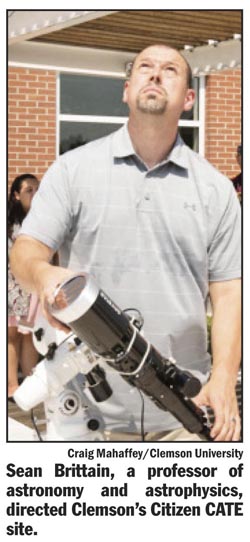CU eclipse experiment a clear success
CLEMSON — While tens of thousands were experiencing the Aug. 21 total solar eclipse on the expansive grounds of Clemson University, professor Sean Brittain and several students from the department of physics and astronomy were collecting scientific data on the roof of the Watt Family Innovation Center.
 Using a telescope and computer software, Brittain and his team gathered images of the sun’s outer atmosphere — the corona — during the 2 minutes and 37 seconds of totality. These images will be compiled with thousands of others taken by 68 identical telescopes placed along the 2,500-mile path of totality, in an effort dubbed the Citizen CATE (Continental-America Telescopic Eclipse) Experiment. They will provide 90 minutes of unprecedented, continuous footage to better understand the details of the sun’s corona.
Using a telescope and computer software, Brittain and his team gathered images of the sun’s outer atmosphere — the corona — during the 2 minutes and 37 seconds of totality. These images will be compiled with thousands of others taken by 68 identical telescopes placed along the 2,500-mile path of totality, in an effort dubbed the Citizen CATE (Continental-America Telescopic Eclipse) Experiment. They will provide 90 minutes of unprecedented, continuous footage to better understand the details of the sun’s corona.
All 68 telescopes were manned by volunteer citizens, including retirees, school kids, teachers, astronomers and college students. Fifty-eight of those sites had clear weather on Aug. 21 and were able to collect data for
You must be logged in to view this content.
Subscribe Today or Login



























